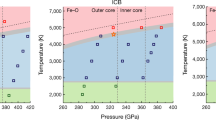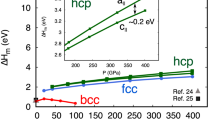Abstract
Recent numerical-modelling and seismological results have raised new questions about the dynamics1,2 and magnetism3,4 of the Earth's core. Knowledge of the elasticity and texture of iron5,6 at core pressures is crucial for understanding the seismological observations, such as the low attenuation of seismic waves, thelow shear-wave velocity7,8 and the anisotropy of compressional-wave velocity9,10,11. The density and bulk modulus of hexagonal-close-packed iron have been previously measured to core pressures by static12 and dynamic13,14 methods. Here we study,using radial X-ray diffraction15 and ultrasonic techniques16, the shear modulus, single-crystal elasticity tensor, aggregate compressional- and shear-wave velocities, and orientation dependence of these velocities in iron. The inner core shear-wave velocity is lower than the aggregate shear-wave velocity of iron, suggesting the presence of low-velocity components or anelastic effects in the core. Observation of a strong lattice strain anisotropy in iron samples indicates a large (∼24%) compressional-wave anisotropy under the isostress assumption, and therefore a perfect alignment of crystals6 would not be needed to explain the seismic observations. Alternatively the strain anisotropy may indicate stress variation due to preferred slip systems.
This is a preview of subscription content, access via your institution
Access options
Subscribe to this journal
Receive 51 print issues and online access
$199.00 per year
only $3.90 per issue
Buy this article
- Purchase on Springer Link
- Instant access to full article PDF
Prices may be subject to local taxes which are calculated during checkout




Similar content being viewed by others
References
Song, X. & Richards, P. G. Seismological evidence for differential rotation of the Earth's inner core. Nature 382, 221–224 (1996).
Su, W., Dziewonski, A. M. & Jeanloz, R. Planet within a planet: rotation of the inner core of Earth. Science 274, 1883–1887 (1996).
Glatzmaier, G. A. & Roberts, P. H. Rotation and magnetism of Earth's inner core. Science 274, 1887–1891 (1996).
Kuang, W. & Bloxham, J. An Earth-like numerical dynamo model. Nature 389, 371–374 (1997).
Jephcoat, A. & Olson, P. Is the inner core of the Earth pure iron? Nature 325, 332–335 (1987).
Stixrude, L. & Cohen, R. E. High-pressure elasticity of iron and anisotropy of Earth's inner core. Science 267, 1972–1975 (1995).
Dziewonski, A. M. & Gilbert, F. Solidity of the inner core of the Earth inferred from normal mode observations. Nature 234, 465–466 (1971).
Masters, G. & Gilbert, F. Structure of the inner core inferred from observations of its spheroidal shear modes. Geophys. Res. Lett. 8, 569–571 (1981).
Shearer, P. M., Toy, K. M. & Orcutt, J. A. Axi-symmetric Earth models and inner-core anisotropy. Nature 333, 228–232 (1988).
Creager, K. C. Anisotropy of the inner core from differential travel times of the phases PKP and PKIKP. Nature 356, 309–314 (1992).
Tromp, J. Support for anisotropy of the Earth's inner core from free oscillations. Nature 366, 678–681 (1993).
Mao, H. K., Wu, Y., Chen, L. C., Shu, J. F. & Jephcoat, A. P. Static compression of iron to 300 GPa and Fe0.8Ni0.2alloy to 260 GPa: Implications for composition of the core. J. Geophys. Res. 95, 21737–21742 (1990).
Brown, J. M. & McQueen, R. G. Phase-transitions, Grüneisen-parameter, and elasticity for shocked iron between 77 GPa and 400 GPa. J. Geophys. Res. 91, 7485–7494 (1986).
Duffy, T. S. & Ahrens, T. J. in High Pressure Research: Application to Earth and Planetary Sciences(eds Syono, Y. & Manghnani, M. H.) 353–361 (Terra Scientific Publishing, Tokyo, 1992).
Singh, A. K., Mao, H. K., Shu, J. & Hemley, R. J. Estimation of single-crystal elastic moduli from polycrystalline x-ray diffraction at high pressure: Applications to FeO and iron. Phys. Rev. Lett. 80, 2157–2160 (1998).
Li, B., Jackson, I., Gasparik, T. & Liebermann, R. C. Elastic wave velocity measurement in multi-anvil apparatus to 10 GPa using ultrasonic interferometry. Phys. Earth Planet. Inter. 98, 79–91 (1996).
Hemley, R. J. et al. X-ray imaging of stress and strain of diamond, iron, and tungsten at megabar pressures. Science 276, 1242–1245 (1997).
Singh, A. K. & Balasingh, C. The lattice strains in a specimen (hexagonal system) compressed nonhydrostatically in an opposed anvil high pressure setup. J. Appl. Phys. 75, 4956–4962 (1994).
Uchida, T., Funamori, N. & Yagi, T. Lattice strains in crystals under uniaxial stress field. J. Appl. Phys. 80, 739–746 (1996).
Anderson, O. L., Isaak, D. G. & Yamamoto, S. Anharmonicity and the equation of state for gold. J.Appl. Phys. 65, 1534–1543 (1989).
Jephcoat, A. P., Mao, H. K. & Bell, P. M. The static compression of iron to 78 GPa with rare gas solids as pressure-transmitting media. J. Geophys. Res. B 91, 4677–4684 (1986).
Simmons, G. & Wang, H. Single Crystal Elastic Constants and Calculated Aggregate Properties(MIT Press, Cambridge, MA, 1971).
Guinan, M. W. & Steinberg, D. J. Pressure and temperature derivatives of the isotropic polycrystalline shear modulus for 65 elements. J. Phys. Chem. Solids 35, 1501–1512 (1974).
Söderlind, P., Moriarty, J. A. & Wills, J. M. First-principles theory of iron up to earth-core pressures: Structural, vibrational, and elastic properties. Phys. Rev. B 53, 14063–14072 (1996).
Dziewonski, A. & Anderson, D. L. Preliminary reference earth model. Phys. Earth Planet. Inter. 25, 297–356 (1981).
Tallon, J. The volume dependence of elastic moduli and the Born–Durand melting hypothesis. Phil. Mag. 39, 151–161 (1979).
Singh, A. K., Balasingh, C., Mao, H. K., Hemley, R. J. & Shu, J. Analysis of lattice strains measured under non-hydrostatic pressure. J. Appl. Phys. 83, 7567–7575 (1998).
Wenk, H. R., Takeshita, T. & Jeanloz, R. Development of texture and elastic anisotropy during deformation of hcp metals. Geophys. Res. Lett. 15, 76–79 (1988).
Romanowicz, B., Li, X. D. & Durek, J. Anisotropy in the inner core: could it be due to low-order convection? Science 274, 963–966 (1996).
Stacey, F. D. Theory of thermal and elastic properties of the lower mantle and core. Phys. Earth Planet. Inter. 89, 219–245 (1995).
Acknowledgements
We thank J. Hu for technical help, L. Stixrude and R. E. Cohen for sharing theoretical data and discussions, T. Duffy for comments, and NSLS and APS for synchrotron beam time; the synchrotron facilities are supported by the DOE. This work was supported by the NSF.
Author information
Authors and Affiliations
Corresponding author
Rights and permissions
About this article
Cite this article
Mao, Hk., Shu, J., Shen, G. et al. Elasticity and rheology of iron above 220 GPa and the nature of the Earth's inner core. Nature 396, 741–743 (1998). https://doi.org/10.1038/25506
Received:
Accepted:
Issue Date:
DOI: https://doi.org/10.1038/25506
This article is cited by
-
Tensorial stress-plastic strain fields in α - ω Zr mixture, transformation kinetics, and friction in diamond-anvil cell
Nature Communications (2023)
-
An initial map of fine-scale heterogeneity in the Earth’s inner core
Nature Geoscience (2022)
-
Electrical and thermal conductivity of Earth’s core and its thermal evolution—A review
Acta Geochimica (2022)
-
Tensorial stress−strain fields and large elastoplasticity as well as friction in diamond anvil cell up to 400 GPa
npj Computational Materials (2019)
-
Experimental constraints on light elements in the Earth’s outer core
Scientific Reports (2016)
Comments
By submitting a comment you agree to abide by our Terms and Community Guidelines. If you find something abusive or that does not comply with our terms or guidelines please flag it as inappropriate.



